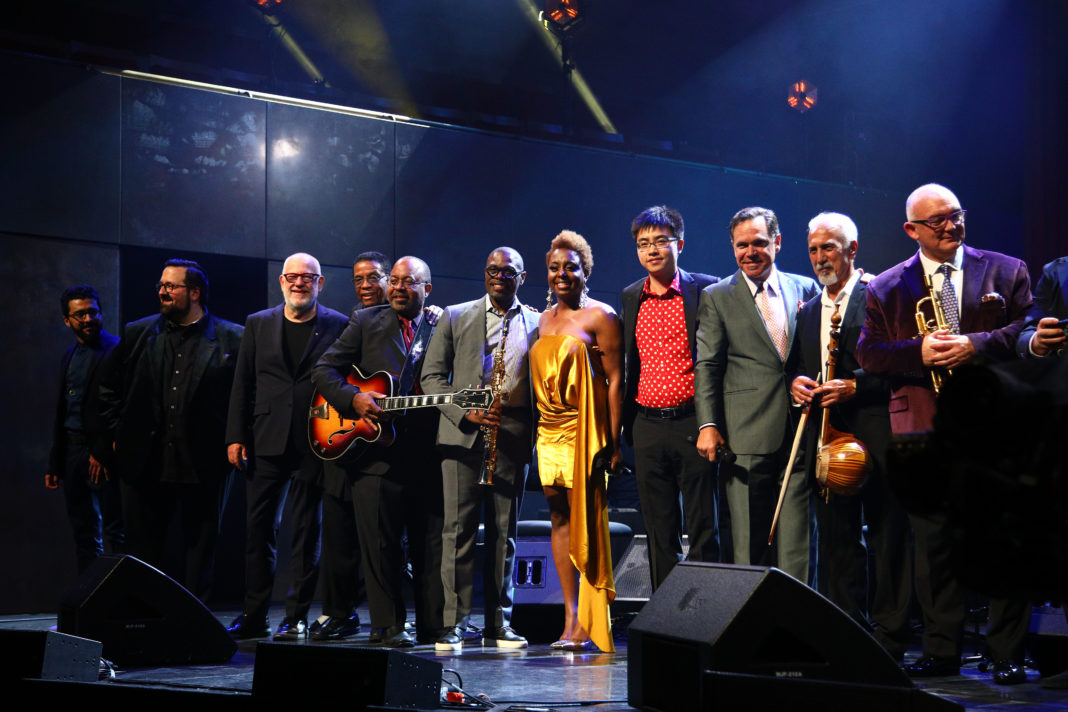The finale is seen during the International Jazz Day 2019 All-Star Global Concert at Hamer Hall on April 30, 2019 in Melbourne, Australia. (Photo by Graham Denholm/Getty Images for Herbie Hancock Institute of Jazz)
Perhaps William Barton said it best in conversation at the event. “We’re unified onstage together. We’re speaking as one voice.” Barton, a virtuoso and scholar of the didgeridoo, the instrument of his aboriginal people, played in an improvised duet with Herbie Hancock, at the flagship concert in Melbourne, Australia, for this year’s International Jazz Day celebration.
The merging of cultures between them seemed to set the perfect tone for concert’s overall theme.
Each year, in countries on every continent (195 nations this year), the jazz art form is celebrated mainly through performance, and each year there is an All-Star Global Concert in a different locale. In addition, the host city is gifted with several days of educational workshops and concerts.
Jazz Day Co-Chair and ICAP Co-President Herbie Hancock (who is also a UNESCO goodwill ambassador) announced to the crowd at Melbourne’s Hamer Hall (and broadcast internationally) that celebrating the spirit of jazz couldn’t be more relevant “at a time when internal and external relationships among so many countries are unsettled.”
By contrast, the very nature of jazz is cooperation, support, and harmonious exchange. And International Jazz Day was established to link humanitarian values to the character of the musical genre.
Among the musical highlights of the day was Mr. Hancock, along with Dutch saxophonist Tineke Postma, and several musicians from Brazil, India and Mexico, delighting the crowd with a rendition of “Beauty and the Beast,” a composition by ICAP’s other co-president, Wayne Shorter.
A large bastion of local Australian musicians shared time with noted musicians including jazz singers Kurt Elling and Jane Monheit, organist Joey DeFrancesco, guitarist Jeff Parker, pianist Eric Reed, bassist Ben Williams and drummer Brian Blade.
Each year, the concert ends with John Lennon’s musical imploring of a world no longer plagued by separation, “Imagine.”
As Mr. Hancock told a radio interviewer from National Public Radio:
“The purpose of this event is to show, through the music, the kind of world that we can live in if we work toward those goals, of respecting everybody . . . it celebrates the cultures of all the groups. This is what jazz really does.”
Mr. Hancock’s comments succinctly sum up the over-arching purpose of the annual celebration, as expressed on the founding organization’s website:
“International Jazz Day brings together communities, schools, artists, historians, academics, and jazz enthusiasts all over the world to celebrate and learn about jazz and its roots, future and impact; raise awareness of the need for intercultural dialogue and mutual understanding; and reinforce international cooperation and communication. Each year on April 30, this international art form is recognized for promoting peace, dialogue among cultures, diversity, and respect for human rights and human dignity; eradicating discrimination; promoting freedom of expression; fostering gender equality; and reinforcing the role of youth in enacting social change.”

